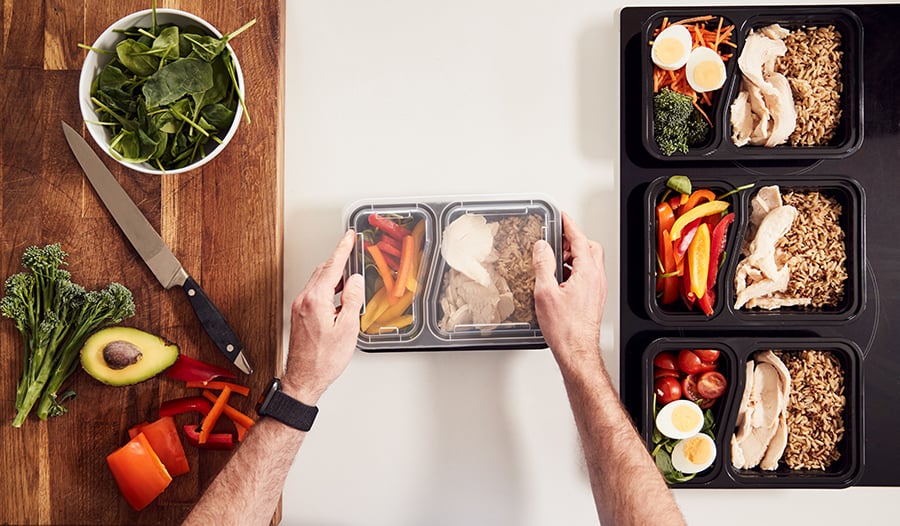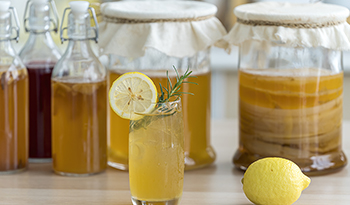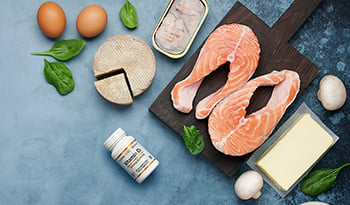Planul de dietă Dukan: faze, liste alimentare, + eficacitate

Ce este dieta Dukan?
Dieta Dukan, o dietă bogată în proteine, cu conținut scăzut de carbohidrați și cu conținut scăzut de grăsimi, a fost concepută în anii 1970 de Dr. Pierre Dukan, fost medic francez și auto-proclamat nutriționist. Cunoscută și sub numele de Planul de dietă Dukan sau Programul de dietă Dukan, această dietă constă în patru faze distincte, în timpul cărora persoanele care urmează dieta pot mânca cât de mult din alimentele „permise” pe care doresc. Dieta extrem de restrictivă se concentrează pe alimentele întregi, mai degrabă decât pe cele procesate și încurajează activitatea fizică zilnică (20-30 de minute de mers pe jos, în funcție de fază). Cercetările sugerează că dietele bogate în proteine, cum ar fi dieta Dukan, sunt eficiente pentru gestionarea greutății, dar pot prezenta riscuri pentru sănătate pe termen lung și pot să nu fie durabile.
Înainte de a începe planul de dietă Dukan, va trebui să calculați „greutatea reală” - o greutate obiectivă realistă bazată pe vârstă, istoricul greutății și alți factori personali. Acest calcul determină cât timp veți petrece în fiecare fază a dietei
Acest articol oferă o imagine de ansamblu asupra dietei Dukan, dacă este eficientă și discută riscurile potențiale ale urmăririi dietei.
Prezentare generală a alimentelor dietetice Dukan: Lista celor 100 de alimente permise
Alimentele pe care le puteți mânca în dieta Dukan variază în funcție de faza în care se află o persoană. Dieta se învârte în jurul unei liste de 100 de alimente aprobate care sunt introduse treptat pe parcursul celor patru faze. Prima fază este o dietă bogată în proteine, cu conținut scăzut de carbohidrați, cu conținut scăzut de grăsimi, în care arzi grăsimi pentru energie în loc de carbohidrați. Se compune aproape în întregime din alimente cu proteine slabe. A doua fază adaugă legume fără amidon, ulei de măslineși fructe de goji. A treia fază adaugă carbohidrați complexi, cum ar fi pâinea integrală și fructele, alimentele cu amidon și brânza tare. De asemenea, include o masă săptămânală de „sărbătoare” constând dintr-o porție fiecare dintr-un aperitiv, aperitiv, desert și un pahar de vin. Faza finală include toate alimentele fără limitare. Toate cele patru faze includ, de asemenea, o porție zilnică de tărâțe de ovăz.
Dieta identifică 100 de alimente care sunt permise pe parcursul fazelor dietei. Aceasta este adesea denumită „lista alimentară Dukan Diet” și include 68 de proteine slabe, inclusiv carne slabă, păsări de curte, pește, crustacee, proteine vegetariene, produse lactate fără grăsimi și ouă și 32 de legume fără amidon, cum ar fi anghinare, sparanghel, broccoli, fasole verde, salată verde, ardei, spanac și dovlecei. Dieta permite, de asemenea, gelatină fără zahăr, shirataki, ulei de măsline, fructe de goji, gluten de grâu și tărâțe de ovăz.
O persoană care urmează dieta Dukan poate mânca o cantitate nelimitată de 68 de alimente bogate în proteine. Aceste alimente includ:
- Carne de vită (numai fripturi sau articole la grătar, și nu bucăți grase, cum ar fi coaste)
- Carne de vită (tăieturi, fripturi sau cotlete bine tăiate)
- Bivol
- Vânat
- Pui
- Turcia
- Alte păsări de curte slabe
- Pește
- Crustacee
- Ouă
- Tofu
Fazele dietei Dukan
Există patru faze ale dietei Dukan. Durata fiecărei faze depinde de obiectivele dvs. de pierdere în greutate:1
- Atac
- Croazieră
- Consolidare
- Stabilizare
Faza de atac
Prima fază a dietei Dukan este faza de atac, cunoscută și sub numele de faza de proteine pure. Faza de atac este o dietă cetogenetică bogată în proteine, cu conținut scăzut de carbohidrați, cu conținut scăzut de grăsimi . Conform dietei, această fază intenționează să „înceapă” gestionarea greutății și durează între două și șapte zile, în funcție de vârsta persoanei, greutatea țintă și cât de multă dietă a făcut în trecut.
Durata fazei se bazează pe obiectivele de pierdere în greutate:
- Mai puțin de 10 kilograme de pierdut: 1-2 zile
- 15-30 de lire sterline de pierdut: 3-5 zile
- Mai mult de 40 de kilograme de pierdut: 5-7 zile (consultați-vă medicul)
Pe lângă faptul că mănâncă numai proteine slabe, persoanele aflate în faza de atac a dietei consumă 1,5 linguri de tărâțe de ovăz și ar trebui să facă exerciții fizice moderate zilnic, cum ar fi 20 de minute de mers pe jos . Persoanele care urmează faza de atac pot consuma, de asemenea, tăiței shirataki, gluten de grâu și până la 1 lingură de fructe de goji.
Cu excepția unei cantități mici de tărâțe de ovăz consumate zilnic, nu sunt permise carbohidrați — inclusiv fructe sau legume — în această primă fază.
Faza de croazieră
A doua fază a dietei, cunoscută sub numele de faza de croazieră, durează atât timp cât este nevoie pentru a atinge obiectivul unei persoane de gestionare a greutății. Dieta estimează că acest lucru va dura trei zile pentru fiecare kilogram de pierdere în greutate dorită.
În timpul fazei de croazieră, persoanelor care urmează dietă li se recomandă să alterneze zilele în care mănâncă numai alimente permise în faza de atac cu zile care includ atât cele 68 de proteine slabe, cât și 32 de legume fără amidon. Aceasta se numește „programul alternativ” - o zi de proteine pure, urmată de o zi de proteine plus legume. În zilele cu proteine și legume, persoanele care urmează dietă pot mânca cât de mult doresc din proteinele și legumele slabe permise.
Cele 32 de legume fără amidon permise în timpul fazei de croazieră includ:
- Anghinare
- Sparanghel
- Sfeclă
- Broccoli
- Morcovi
- Țelină
- Castravete
- Vinete
- Salată verde
- Ciuperci
- Ceapă
- Ardei
- Spanac
- Roșii
- Dovlecei
În această fază, nu sunt permise legume amidonice, cum ar fi cartofii sau porumbul. În zilele de proteine și legume, persoanele care urmează faza a doua a dietei pot adăuga, de asemenea, ulei de măsline și până la 2 linguri de fructe de goji. În timpul fazei de croazieră, persoanele care urmează dieta ar trebui să mănânce 2 linguri de tărâțe de ovăz și să meargă rapid timp de 30 de minute zilnic.
Această fază continuă până când persoana care urmează dieta își atinge greutatea țintă.
Faza de consolidare
A treia etapă a dietei, cunoscută sub numele de faza de consolidare, este concepută pentru a preveni recâștigarea greutății pierdute în primele două faze. Faza de consolidare durează cinci zile pentru fiecare kilogram pierdut, conform dietei. În timpul celor două etape ale acestei faze, alimentele restricționate anterior sunt adăugate treptat înapoi într-o ordine specificată.
Alimentele adăugate înapoi în timpul fazei de consolidare includ:
- 1 până la 2 porții de fructe (cu excepția bananelor, strugurilor, smochinelor sau cireșelor)
- 2 felii de pâine integrală
- 1,5 uncii de brânză cu coajă tare
- 1 până la 2 porții de alimente amidonice săptămânal
- 1 până la 2 mese „de sărbătoare” săptămânal
Persoanele care urmează dieta continuă să adere la o zi de proteină pură din faza de atac o dată pe săptămână. De asemenea, consumă 2 linguri de tărâțe de ovăz și se angajează în 25 de minute de mers rapid zilnic în această fază. Mesele săptămânale de „sărbătoare” constau într-o porție de aperitiv, aperitiv, desert și un pahar de vin.
Faza de stabilizare
În faza finală de stabilizare, persoanele care urmează dieta își propun să continue aceleași obiceiuri pentru tot restul vieții și să-și mențină greutatea țintă. Cele trei reguli ale acestei faze includ:
- Consumați 3 linguri de tărâțe de ovăz zilnic
- Alegeți să urcați scările ori de câte ori este posibil
- Aderați la o zi de „proteine pure” în fiecare joi
În timpul stabilizării, urmăriți cel puțin 20 de minute de mers pe jos zilnic și faceți schimbări în stilul de viață, cum ar fi să luați scări în loc de ascensoare.
Toate celelalte alimente sunt permise în această fază.
Cât de eficientă este dieta Dukan?
În timp ce persoanele care urmează dieta Dukan pot pierde în greutate, natura restrictivă a dietei ridică unele îngrijorări. Primele două faze ale dietei limitează sever ce alimente sunt permise, ceea ce poate îngreuna satisfacerea nevoilor lor nutritive.
Într-un studiu care a analizat aportul de nutrienți a 51 de femei care au urmat Dieta Dukan, autorii au descoperit multe anomalii nutriționale la femeile aflate în dietă - aportul de proteine animale a fost excesiv, aportul de carbohidrați a fost scăzut și aportul anumitor micronutrienți, cum ar fi vitamina C și folat a fost insuficient. 2
O altă preocupare este aportul ridicat de proteine din dietă, în special în prima și a doua fază. Cercetările au arătat, de asemenea, că dietele bogate în proteine pot duce la complicații de sănătate, cum ar fi bolile cardiovasculare.2 Consumul excesiv de proteine înseamnă, de asemenea, că ficatul și rinichii trebuie să muncească din greu pentru a procesa produsele secundare ale metabolismului proteinelor - și există o limită a cantității de proteine pe care rinichii le pot gestiona. Dukan spune că a bea multă apă va rezolva această problemă, dar nu oferă referințe științifice care să susțină acest lucru.
Într-adevăr, în același studiu care examinează aportul de nutrienți al femeilor care urmează dieta Dukan, autorii concluzionează că „Adoptarea acestei diete pe termen lung poate reprezenta amenințări pentru sănătate prin dobândirea bolilor renale și hepatice, osteoporozei și bolilor cardiovasculare.”
În plus față de riscurile nutriționale prezentate de dieta Dukan, natura restrictivă a acestei diete și a altor diete poate crește riscul de a dezvolta o alimentație dezordonată.
Unele dintre regulile dietei Dukan sunt, de asemenea, contradictorii. De exemplu, legumele sunt limitate la soiurile cu conținut scăzut de amidon, dar sunt permise lactate fără grăsimi, care sunt mai bogate în zahăr și carbohidrați (până la 32 uncii pe zi). Dukan elimină zaharurile din lapte din aceste produse, spunând că numărul de zaharuri este prea mic pentru a vă face griji. Dar apoi restricționează legumele cu conținut scăzut de amidon, care sunt chiar mai scăzute în zaharuri și carbohidrați.
Ghidurile dietetice ale Departamentului Agriculturii din SUA (USDA) includ recomandări de calorii și sfaturi pentru o dietă sănătoasă și echilibrată. Ca o dietă bogată în proteine care restricționează alte grupuri alimentare importante, cum ar fi carbohidrații și grăsimile sănătoase, Dieta Dukan nu respectă liniile directoare federale privind dieta. Pe baza celor mai recente cercetări, USDA recomandă 5 1/2 uncii (aproximativ 3 căni) de alimente proteice pe zi pentru cineva care mănâncă o dietă de 2.000 de calorii.4 Dieta Dukan are o săptămână întreagă de consum numai de proteine, urmată de zile alternante de numai proteine.
Ar trebui să încerc dieta Dukan?
Dieta Dukan nu este potrivită pentru toată lumea. Persoanele cu boli de rinichi, boli de inimă, diabet sau cele care sunt însărcinate sau alăptează ar trebui să evite această dietă. Conținutul ridicat de proteine poate încorda rinichii, iar lipsa anumitor nutrienți poate prezenta riscuri pentru sănătate.
Dieta Dukan poate ajuta la gestionarea eficientă a greutății, deoarece restricționează caloriile, carbohidrații și grăsimile. În plus, s-a demonstrat că dietele bogate în proteine promovează scăderea în greutate prin modificarea nivelurilor de hormoni specifici care reglează foamea și apetitul. Prin urmare, creșterea aportului de proteine ar putea ajuta la scăderea foamei și a aportului caloric, ducând la pierderea în greutate.
Cu toate acestea, este important să consultați un dietetician înregistrat care vă poate ajuta să găsiți cel mai bun plan de dietă și să creați un plan complet, individualizat, care include o nutriție echilibrată, exerciții fizice regulate, somn adecvat și gestionarea de succes a stresului pentru pierderea în greutate sigură și durabilă.
Referințe:
- Faza de atac al dietei Dukan | Dukandiet.com | Accesat 8/10/23
- Wyka J, Malczyk E, Misiarz M, Zolotenka-Synowiec M, Calyniuk B, Baczynska S. Evaluarea consumului de alimente pentru femeile care adoptă dieta Dukan bogată în proteine. Rocz Panstw Zakl August 2015; 66 (2) :137-142.
- Colombarolli MS, de Oliveira J, Cordas TA. Pofta de carbohidrați: pofta de mâncare și alimentația dezordonată la dietele cu conținut scăzut de carbohidrați și asocierea acesteia cu postul intermitent. Mănâncă tulburare de greutate. 2022; 27 (8): 3109-3117.
- Orientări dietetice pentru americani 2020-2025 | USDA | Accesat 8/11/23.
Declarație de declinare a responsabilității:Acest blog nu are ca scop să ofere un diagnostic.














































































 Cuprins
Cuprins















